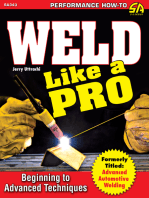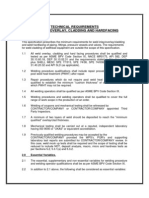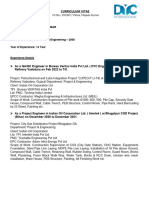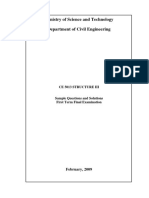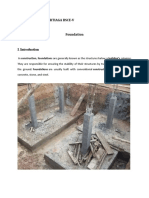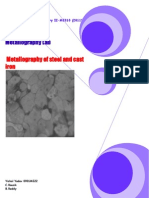Distance Between Welds (1)
Distance Between Welds (1)
Uploaded by
ameeraliCopyright:
Available Formats
Distance Between Welds (1)
Distance Between Welds (1)
Uploaded by
ameeraliCopyright
Available Formats
Share this document
Did you find this document useful?
Is this content inappropriate?
Copyright:
Available Formats
Distance Between Welds (1)
Distance Between Welds (1)
Uploaded by
ameeraliCopyright:
Available Formats
CLASSIFICATION: C1 - CONTROLLED
SPECIFICATION FOR FABRICATION, INSTALLATION, INSPECTION &
TESTING OF METALLIC PIPES
DOC NO: 4329-RP129C-5-14-0007 REV. B
aa) Scars or undercut remaining after the removal of temporary attachments shall be
repaired in accordance with the QatarEnergy approved procedure. This shall be ground
flush with the surface of the base metal and subjected to MPI for CS pipe work/LPI for
austenitic pipe work before the joint is offered for final inspection. Each case shall be
recorded as a repair.
bb) Vertical down welding is not permitted.
cc) For the tie-ins weld joints with the existing piping the following shall applicable:
• Ultrasonic lamination check shall be carried at the tie-in location before any cut.
• MPI shall be carried out on the bevel of the existing pipe.
• Preheat shall be carried out as per Section 330 of QP-STD-R-002 & Section 330
of QP-STD-R-003 for the existing material.
• The root pass shall be checked by MPI.
• Preheat shall be carried out as specified above before depositing the hot pass.
• After weld completion the PWHT shall be carried out as per 331.1.1. of ASME
B31.3.
• The completed welds shall be subjected to 100% RT and MPI.
4.5.2 FILLET & SOCKET WELDS
Filet welds including socket welds shall be as per ASME B31.3 figure 328.5.2A & B. Whenever
practicable, fillet welded joints should have a minimum of three weld passes, two of which should
be showing for visual inspection.
4.5.3 SEAL WELDS
Seal welding shall be done by a qualified welder. Seal welds shall cover all exposed threads.
Joints to be seal welded shall be made up clean and without the use of tape or any compound.
A qualified welder shall perform welding in accordance with qualified welding procedure. The
welding shall not cause damage to the threaded fitting and the seal weld shall cover all exposed
threads.
4.5.4 WELDED BRANCH CONNECTIONS
Branch connections shall be as per ASME B31.3, figure 328.5.4A to 328.5.4E, but this illustration
shall not be intended to exclude acceptable types of constructions not shown. For branch
connections larger than 2”, wherever practical, a band centred on the location of the proposed
branch shall be ultrasonically examined to confirm the quality of the parent pipe.
4.5.5 PROXIMITY OF WELDS
The distance between welds on piping shall be in accordance with the requirements of
QatarEnergy engineering specification QP-STD-R-002 and QP-STD-R-003. The minimum
distance between the toes of adjacent butt welds shall be at least equal to the pipe diameter or
Page 28 of 46
CLASSIFICATION: C1 - CONTROLLED
SPECIFICATION FOR FABRICATION, INSTALLATION, INSPECTION &
TESTING OF METALLIC PIPES
DOC NO: 4329-RP129C-5-14-0007 REV. B
100 mm whichever is higher. The minimum distance between the toes of a butt weld and an
adjacent attachment weld shall be at-least four times the nominal wall thickness of the pipe but
never less than 50 mm.
Attachment of non-pressure parts by welds which cross existing main welds or for which the
minimum nominal distance between the toe of the attachment weld and the toe of the existing
main welds or branch welds is less than the smaller of twice the thickness of the main pressure
pipe or 40 mm should be avoided.
If unavoidable the area to be welded over shall be subject to 100% surface crack detection and
100% ultrasonic examination prior to welding; after welding the welds and adjacent area shall
be similarly examined.
Fabricated Laps are not permitted.
4.6 WELD REPAIRS
Repair of welds shall be done as per welding procedure qualified as per Clause 10.3 of this
specification.
Repair welds shall be done by welders or welding operators qualified as per Clause 10.1.
Preheating (if applicable) and heat treatment shall be as required for original welding.
Injurious surface defects shall be completely removed by grinding. The ground out area shall be
repaired by welding if defect removal results in reduction of pipe wall below minimum thickness.
The repaired area shall be ground smooth to the pipe contour.
CONTRACTOR shall not repair any repeated injurious defect without QatarEnergy’s written
approval. Unless otherwise specified, surface defects are considered injurious if the defect
extends below the specified minimum wall thickness or is more than 1.6mm in depth.
Duplex stainless steels shall only be subject to 1 weld repair unless otherwise agreed with the
QatarEnergy.
The repair rate shall be reported on a lineal basis, submitted to the QatarEnergy /TPIA on a
weekly basis and shall not exceed 3% during production. If this level is exceeded the
CONTRACTOR shall investigate the reasons responsible for the increased repair rate and
report his findings to the QatarEnergy /TPIA with a proposed method of rectification.
𝐏𝐞𝐫𝐜𝐞𝐧𝐭𝐚𝐠𝐞 𝐑𝐞𝐩𝐚𝐢𝐫 𝐑𝐚𝐭𝐞 = 𝐃𝐞𝐟𝐞𝐜𝐭𝐢𝐯𝐞 𝐋𝐞𝐧𝐠𝐭𝐡 𝐑𝐞𝐩𝐚𝐢𝐫 x 100
𝐓𝐨𝐭𝐚𝐥 𝐥𝐞𝐧𝐠𝐭𝐡 𝐨𝐟 𝐰𝐞𝐥𝐝𝐢𝐧𝐠 𝐜𝐨𝐦𝐩𝐥𝐞𝐭𝐞𝐝
No rectification, repair or modification may be made without the approval of QatarEnergy /TPIA.
Extent of cracks in welds or base metal shall be ascertained by use of non-destructive
inspection. The cause of cracking shall be established prior to removal and repair, a full report
issued on cause and corrective action.
Page 29 of 46
You might also like
- Storage Tank Inspection API 650Document27 pagesStorage Tank Inspection API 650Pandu Damay Putra93% (14)
- Fabrication Procrdure Metering SkidDocument11 pagesFabrication Procrdure Metering SkidgstketutNo ratings yet
- Contractor's Guide for Installation of Gasketed PVC Pipe for Water / for SewerFrom EverandContractor's Guide for Installation of Gasketed PVC Pipe for Water / for SewerRating: 5 out of 5 stars5/5 (1)
- ITP For Communication System InstallationDocument5 pagesITP For Communication System InstallationGanga Daran100% (3)
- Repair Procedures: Connection Field Repair (Refacing)Document5 pagesRepair Procedures: Connection Field Repair (Refacing)islam atif100% (1)
- Weld Like a Pro: Beginning to Advanced TechniquesFrom EverandWeld Like a Pro: Beginning to Advanced TechniquesRating: 4.5 out of 5 stars4.5/5 (6)
- Stainless Steel Socket-Set Screws: Standard Specification ForDocument5 pagesStainless Steel Socket-Set Screws: Standard Specification FormsbarretosNo ratings yet
- PIPE LINE Presentation PART 1Document33 pagesPIPE LINE Presentation PART 1kannan100% (2)
- Procedure For WeldingDocument7 pagesProcedure For Weldingshikh vasimNo ratings yet
- Annexure To SOW 3 STD Specification For Welding and NDT PipingDocument15 pagesAnnexure To SOW 3 STD Specification For Welding and NDT PipingASHISH GORDENo ratings yet
- 00-Contract 4C.4 Specifications For Pipeline WorksDocument9 pages00-Contract 4C.4 Specifications For Pipeline WorksALINo ratings yet
- NS-1-60. Disposition of DefectsDocument4 pagesNS-1-60. Disposition of DefectsWHWENNo ratings yet
- B2020-TDC-VF-009 Vessel Fabrication R0Document5 pagesB2020-TDC-VF-009 Vessel Fabrication R0Ramalingam Prabhakaran100% (1)
- 12 - Exhibit C Sp-Welding of Pipelines &facilitiesDocument13 pages12 - Exhibit C Sp-Welding of Pipelines &facilitiesMoaatazz Nouisri100% (1)
- 13. MAINLINE WELDINGDocument6 pages13. MAINLINE WELDINGPallab JanaNo ratings yet
- Asme B31.4 - 2016 EndDocument1 pageAsme B31.4 - 2016 Endwilliam cordero valverdeNo ratings yet
- PipingDocument8 pagesPipingRajkumar ANo ratings yet
- Api 510 NotificationDocument15 pagesApi 510 NotificationAhmed ShakirNo ratings yet
- Casing and Tubing Crossovers: ScopeDocument4 pagesCasing and Tubing Crossovers: Scopeislam atifNo ratings yet
- Prosedur PipaDocument16 pagesProsedur PipaDaengkulle Firmansyah PuteraNo ratings yet
- Access Fitting Weld ProcedureDocument2 pagesAccess Fitting Weld Procedurewhah11No ratings yet
- M182B Atmc Extension Testing Bays and Showroom Mezzanine Floor Havc Requirements, Al Quoz Ind. 1, DubaiDocument3 pagesM182B Atmc Extension Testing Bays and Showroom Mezzanine Floor Havc Requirements, Al Quoz Ind. 1, Dubaipokemonking2303No ratings yet
- Enbridge Pipeline Repair Workplan WeldingDocument23 pagesEnbridge Pipeline Repair Workplan WeldingJesus MaestreNo ratings yet
- Api - 653 Exame PreparatoryDocument12 pagesApi - 653 Exame PreparatoryEngr Shahid AliNo ratings yet
- Api-582-2016-Welding-Guidelines-For-The-Chemical-Oil-And-Gas-Industries-Apiasme-Practice-Test Clause 11.3Document4 pagesApi-582-2016-Welding-Guidelines-For-The-Chemical-Oil-And-Gas-Industries-Apiasme-Practice-Test Clause 11.3Ahmed ElsharkawNo ratings yet
- Fabrication Inspection ProcedureDocument11 pagesFabrication Inspection Procedurewill_herry100% (7)
- Enbridge Pipeline Repair Workplan Welding PDFDocument23 pagesEnbridge Pipeline Repair Workplan Welding PDFquiron2014No ratings yet
- Api 510 NotesDocument26 pagesApi 510 NotesAhmed Shakir100% (1)
- Shop Welding InspectionDocument4 pagesShop Welding InspectionIndra Nath MishraNo ratings yet
- ML 07 WeldingDocument11 pagesML 07 WeldingDeepakNo ratings yet
- TopCoreBelco 101 FCDocument9 pagesTopCoreBelco 101 FCCesar ArellanoNo ratings yet
- RP 2007-18 App.DDocument3 pagesRP 2007-18 App.DdrailotaNo ratings yet
- 2.2.2 Technical Requirements For Weld Overlay, Cladding & HardfacingDocument6 pages2.2.2 Technical Requirements For Weld Overlay, Cladding & Hardfacingim4uim4uim4u100% (4)
- 44AC9100-000-V.02-0105-A4 - Rev B - GENERAL SPECIFICATION FOR WELDED TUBE TO TUBE SHEET JOINTDocument8 pages44AC9100-000-V.02-0105-A4 - Rev B - GENERAL SPECIFICATION FOR WELDED TUBE TO TUBE SHEET JOINTAvinash ShuklaNo ratings yet
- AnnexuresDocument29 pagesAnnexuresammarashraf91No ratings yet
- NDT of PipingDocument1 pageNDT of PipingVu Tung LinhNo ratings yet
- Integral Joint Tubing (TTRD) : General RequirementsDocument5 pagesIntegral Joint Tubing (TTRD) : General Requirementsislam atifNo ratings yet
- Procedure For WeldingDocument7 pagesProcedure For WeldingMecon Hyderabad100% (2)
- 33KV GTP WbsebDocument13 pages33KV GTP Wbsebmaniking1100% (1)
- Debswana DP 0gs104Document28 pagesDebswana DP 0gs104Riyadi HendraNo ratings yet
- RP 2007-18 App.BDocument24 pagesRP 2007-18 App.BdrailotaNo ratings yet
- C 1460 - 04 - Qze0njaDocument4 pagesC 1460 - 04 - Qze0njaSamuel EduardoNo ratings yet
- Part 4.4.2.12 Piling. FINALDocument19 pagesPart 4.4.2.12 Piling. FINALMirna KristiyantoNo ratings yet
- 2-Asme BPVC Section Ix-2013Document2 pages2-Asme BPVC Section Ix-2013Reda ElsawyNo ratings yet
- Weld Overlay Procedure For InconelDocument3 pagesWeld Overlay Procedure For InconelArash Mohamadi100% (3)
- Bonald: Dhofar Power Company SAOGDocument1 pageBonald: Dhofar Power Company SAOG54045114No ratings yet
- InterviewDocument22 pagesInterviewsivacwi100% (1)
- Section 6 - Manholes, Frames, Covers and Cleanouts 6-01. General RequirementsDocument3 pagesSection 6 - Manholes, Frames, Covers and Cleanouts 6-01. General RequirementsThupten Gedun Kelvin Ong100% (1)
- Technical Specification For 33 KV, Single Phase, Dead Tank TypeDocument11 pagesTechnical Specification For 33 KV, Single Phase, Dead Tank Typechandrakanth0083396No ratings yet
- 2 Welding Procedure 2 PDFDocument6 pages2 Welding Procedure 2 PDFMustafa MubderNo ratings yet
- DG BusductDocument16 pagesDG BusductanandpurushothamanNo ratings yet
- STANDART PROCEDURE Welding Dan TestingDocument6 pagesSTANDART PROCEDURE Welding Dan TestingvayakunNo ratings yet
- Fab & Erection Pro 20000klR1Document17 pagesFab & Erection Pro 20000klR1Gandhi OnoNo ratings yet
- 80080-TCH-0000-SP-003 - SIGNED-Coating ProcedureDocument7 pages80080-TCH-0000-SP-003 - SIGNED-Coating ProcedurePaul NieNo ratings yet
- 6-15-0003 Rev 4Document9 pages6-15-0003 Rev 4cynideNo ratings yet
- Building Standards ActDocument2 pagesBuilding Standards ActLungisaniNo ratings yet
- 99 JJ 195129 I 9 I 1111211 IjjuudDocument24 pages99 JJ 195129 I 9 I 1111211 IjjuudallswellelleNo ratings yet
- Exam July 2021Document16 pagesExam July 202101280724321 Helmy100% (1)
- Feeder PillarsDocument43 pagesFeeder PillarsRyan BrittNo ratings yet
- Pipelines and City Gate Natural Gas Ram Station - Nigeria: Cable ScheduleDocument7 pagesPipelines and City Gate Natural Gas Ram Station - Nigeria: Cable ScheduleDanilo QuevedoNo ratings yet
- How to prepare Welding Procedures for Oil & Gas PipelinesFrom EverandHow to prepare Welding Procedures for Oil & Gas PipelinesRating: 5 out of 5 stars5/5 (1)
- S. No Tno Orc No Name Designation Contractor Departmen T (For Etas Mapping) Contract or Section (For Etas Mappin G)Document1 pageS. No Tno Orc No Name Designation Contractor Departmen T (For Etas Mapping) Contract or Section (For Etas Mappin G)ameeraliNo ratings yet
- Name of The Person Desgination RemarksDocument1 pageName of The Person Desgination RemarksameeraliNo ratings yet
- Visa Expired List-01Document1 pageVisa Expired List-01ameeraliNo ratings yet
- Step No. Sequence of Activities Hazard Who or What May Be Harmed? Control Measures / Recovery Measures Action / Responsible PartyDocument2 pagesStep No. Sequence of Activities Hazard Who or What May Be Harmed? Control Measures / Recovery Measures Action / Responsible PartyameeraliNo ratings yet
- Step No. Sequence of Activities Hazard Who or What May Be Harmed? Control Measures / Recovery Measures Action / Responsible PartyDocument2 pagesStep No. Sequence of Activities Hazard Who or What May Be Harmed? Control Measures / Recovery Measures Action / Responsible PartyameeraliNo ratings yet
- Step No. Sequence of Activities Hazard Who or What May Be Harmed? Control Measures / Recovery Measures Action / Responsible PartyDocument7 pagesStep No. Sequence of Activities Hazard Who or What May Be Harmed? Control Measures / Recovery Measures Action / Responsible PartyameeraliNo ratings yet
- S.No Check List No: List of Method StatementDocument3 pagesS.No Check List No: List of Method StatementameeraliNo ratings yet
- B5D ElDocument6 pagesB5D ElBALAKRISHNANNo ratings yet
- Process Industry Practices Structural: PIP STF05530 Grating Fabrication DetailsDocument13 pagesProcess Industry Practices Structural: PIP STF05530 Grating Fabrication DetailsloukmanNo ratings yet
- Product Technical Guide For Self Drilling Screws Technical Information ASSET DOC LOC 1577675 PDFDocument12 pagesProduct Technical Guide For Self Drilling Screws Technical Information ASSET DOC LOC 1577675 PDFMahmoud GwailyNo ratings yet
- PDF (1) WorkshopDocument24 pagesPDF (1) Workshopbob123No ratings yet
- Liquid Level Switches Asme B31.1 ConstructionDocument36 pagesLiquid Level Switches Asme B31.1 Constructionsamer8saifNo ratings yet
- Deichman LibraryDocument6 pagesDeichman LibraryFatema SoffarNo ratings yet
- Clancy Company Profile Experience ExpertiseDocument23 pagesClancy Company Profile Experience ExpertiseDann TranNo ratings yet
- VGB 501-H eDocument102 pagesVGB 501-H ehamed karimiNo ratings yet
- DYCINT-Patna-Rajeev Kumar - CivilDocument6 pagesDYCINT-Patna-Rajeev Kumar - CivilParag WadekarNo ratings yet
- MEC481 Course InfoDocument2 pagesMEC481 Course InfoRusyidiAbdullahNo ratings yet
- CE5013 Structure III PDFDocument52 pagesCE5013 Structure III PDFNyein ZawNo ratings yet
- HRT 16TH Oct 2022Document4 pagesHRT 16TH Oct 2022Pujan Amit GurungNo ratings yet
- Assignment in FoundationDocument6 pagesAssignment in FoundationFrancis Prince ArtiagaNo ratings yet
- Metallography Lab Metallography Lab Metallography Lab Metallography LabDocument14 pagesMetallography Lab Metallography Lab Metallography Lab Metallography Labvishaly_450% (2)
- 1.1.4 Parties in The Construction IndustryDocument1 page1.1.4 Parties in The Construction IndustryMohamed ShibleyNo ratings yet
- Plate and Frame Heat Exchanger IOMDocument28 pagesPlate and Frame Heat Exchanger IOMFlorian_AngererNo ratings yet
- Procurement and Contract ManagementDocument50 pagesProcurement and Contract ManagementZeleke TaimuNo ratings yet
- Book 1Document10 pagesBook 1Akun KoreaNo ratings yet
- Manufacturers & Suppliers of Forged Flanges: Corporate OfficeDocument4 pagesManufacturers & Suppliers of Forged Flanges: Corporate Officeabhishek_negi_41No ratings yet
- Metallic Materials - Prevention of Brittle Fracture in New AssetsDocument17 pagesMetallic Materials - Prevention of Brittle Fracture in New Assetskarthicbc2020No ratings yet
- 72.11.00 Reduction GearboxDocument6 pages72.11.00 Reduction GearboxBruna ZaireNo ratings yet
- Technical - Description Robox - Lobe - ENG r1 211117Document20 pagesTechnical - Description Robox - Lobe - ENG r1 211117Nirmal KumarNo ratings yet
- Considerations For ASTM D3039 Composite Tensile TestingDocument3 pagesConsiderations For ASTM D3039 Composite Tensile TestingAmina MASMOUDINo ratings yet
- The CO Uptake of Concrete in A 100 Year Perspective: Claus Pade, Maria GuimaraesDocument9 pagesThe CO Uptake of Concrete in A 100 Year Perspective: Claus Pade, Maria Guimaraesrola atefNo ratings yet
- Chemical Admixture - MonographDocument67 pagesChemical Admixture - MonographUrvasi Vandana TalapalaNo ratings yet
- bt cad cơ bảnDocument21 pagesbt cad cơ bảnVõ Huỳnh Hữu NghịNo ratings yet
- CHC - Vol - 1 - Master - Plan - FINALDocument65 pagesCHC - Vol - 1 - Master - Plan - FINALsbiswas21No ratings yet
- DEWA Water Regulations (Buildings) - 2008 PDFDocument23 pagesDEWA Water Regulations (Buildings) - 2008 PDFSameeh Kaddoura0% (1)





